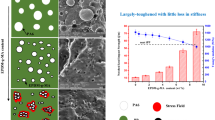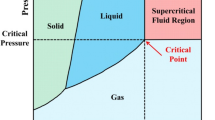Abstract
In this study, we developed a new type of thermo-expandable microcapsules (TEMs) with the anionic/nonionic waterborne polyurethane as the shell and low boiling point agent, n-hexane, as the blowing agent. Thermo-gravimetric analyzer (TGA), laser particle size analyzer, thermo-mechanical analyzer (TMA) and scanning electron microscope (SEM) were used to investigate the blowing agent encapsulation, particle sizes and expansion performances of the TEMs, respectively. Results showed that the nonionic hydrophilic monomer, polyethylene glycol monomethyl ether (MPEG), improved the amount of encapsulation and encapsulation efficiency of n-hexane in TEMs and affected the expansion performance of the TEMs. When the amount of MPEG was 13.4 wt%, the amount of encapsulation and encapsulation efficiency of n-hexane in TEMs could reach 13.2 wt% and 66%, respectively, with the particle size of about 80 nm. 1,4-Butanediol (BDO) enhanced the encapsulation of n-hexane in TEMs. When the amount of BDO was 33.2 mol %, DMPA was 6.7 wt % and MPEG was 13.4 wt %, respectively, the TEMs showed good thermo-expansion performance. The TEMs showed the onset expansion temperature of 206 °C, the peak expansion temperature of 220 °C, and the expansion ratio of 4.1 times, respectively. The successful foaming of the TEMs in epoxy resin indicates that the prepared TEMs have great potentials in foam material applications.









Similar content being viewed by others
References
Colton JS, Suh NP (1987) Nucleation of microcellular foam: theory and practice. Polym Eng Sci 27(7):500–503. https://doi.org/10.1002/pen.760270704
Chen J, Liu T, Zhao L et al (2013) Experimental measurements and modeling of solubility and diffusivity of CO2 in polypropylene/micro- and nanocalcium carbonate composites. Ind Eng Chem Res 52(14):5100–5110. https://doi.org/10.1021/ie303587r
Collias DI, Baird DG, Borggreve RJM (1994) Impact toughening of polycarbonate by microcellular foaming. Polymer 35(18):3978–3983. https://doi.org/10.1016/0032-3861(94)90283-6
Stefani PM, Barchi AT, Sabugal J et al (2003) Characterization of epoxy foams. J Appl Polym Sci 90(11):2992–2996. https://doi.org/10.1002/app.13006
Gendron R, Champagne MF, Li H et al (2010) The supercritical state paradigm in thermoplastic foaming. Cell Polym 29(5):283–300. https://doi.org/10.1177/026248931002900502
You M, Zhang XX, Wang XC et al (2010) Effects of type and contents of microencapsuled n-alkanes on properties of soft polyurethane foams. Thermochim Acta 500(1):69–75. https://doi.org/10.1016/j.tca.2009.12.013
Rheem MJ, Jung H, Ha J et al (2017) Suspension polymerization of thermally expandable microspheres using low-temperature initiators. Colloids Polym Sci 295:171–180. https://doi.org/10.1007/s00396-016-3993-5
Lebedeva NV, Samder SN, Ina M et al (2016) Multicore expandable microbubbles: controlling density and expansion temperature. Polymer 90:45–52. https://doi.org/10.1016/j.polymer.2016.02.050
Park CB, Suh NP (1996) Filamentary extrusion of microcellular polymers using a rapid decompressive element. Polym Eng Sci 36(1):34–48. https://doi.org/10.1002/pen.10382
Farzaneh S, Fitoussi J, Lucsas A et al (2013) Shape memory effect and properties memory effect of polyurethane. J Appl Polym Sci 128(5):3240–3249. https://doi.org/10.1002/app.38530
Ling J, Rong MZ, Zhang MQ (2014) Effect of molecular weight of PEG soft segments on photo-stimulated self-healing performance of coumarin functionalized polyurethanes. Chin J Polym Sci 32(10):1286–1297. https://doi.org/10.1007/s10118-014-1522-x
Ou CW, Su CH, Jeng US et al (2014) Characterization of biodegradable polyurethane nanoparticles and thermally induced self-assembly in water dispersion. ACS Appl Mater Interfaces 6(8):5685–5694. https://doi.org/10.1021/am500213t
Kou E, Lee S, Shin J et al (2013) Renewable polyurethane microcapsules with isosorbide derivatives for self-healing anticorrosion coatings. Ind Eng Chem Res 52(44):15541–15548. https://doi.org/10.1021/ie402505s
Azimi HR, Rezaei M, Abbasi F (2011) The effect of expansion conditions on the batch foaming dynamics of St-MMA copolymer. J Cell Plast 48:125–140. https://doi.org/10.1177/0021955x11432960
Yasuhiro K, Daichi I (2010) Thermally expandable microcapsules for polymer foaming-relationship between expandability and viscoelasticity. Polym Eng Sci 50:835–842. https://doi.org/10.1002/pen.21595
Hou ZS, Xia Y, Qu W et al (2015) Preparation and properties of thermoplastic expandable microspheres with P(VDC-AN-MMA) shell by suspension polymerization. Int J Polym Mater 64:427–431. https://doi.org/10.1080/00914037.2014.958831
Hou ZS, Zhang H, Ji CX (2015) Preparation and properties of thermal-expandable microspheres with P(VDC-AN-St) shell by suspension polymerization. Polym Mater Sci Eng 31:49–52. https://doi.org/10.1080/00914037.2014.958831
Vamvounis G, Jonsson M, Hult A (2013) Synthesis and properties of poly(3-n-dodecylthiophene) modified thermally expandable microspheres. Eur Polym J 49:1503–1509. https://doi.org/10.1016/j.eurpolymj.2013.01.010
Bai X, Li J, Wang CY (2020) Thermo-expandable microcapsules with polyurethane as the shell. J Polym Res 27:185. https://doi.org/10.1007/s10965-020-02160-y
Alizadegan F, Pazokifard S, Mirabedini SM et al (2017) Polyurethane-based microcapsules containing reactive isocyanate compounds: study on preparation procedure and solvent replacement. Colloids Surf A 529:750–759. https://doi.org/10.1016/j.colsurfa.2017.06.058
Maria K, Dimitrios G, Bekas B et al (2019) Microcapsule-based self-healing materials: healing efficiency and toughness reduction vs. capsule size. Compos B 171:78–86. https://doi.org/10.1016/j.compositesb.2019.04.030
Rui W, Yao X (2020) Preparation of monosultap-polyurethane microcapsules in an inverse emulsion through interfacial polymerization. J Appl Polym Sci 137:48594. https://doi.org/10.1002/app.48594
Li HY, Ma YJ, Li ZK et al (2018) Synthesis of novel multilayer composite microcapsules and their application in self-lubricating polymer composites. Composites Sci Technol 164:120–128. https://doi.org/10.1016/j.compscitech.2018.05.042
Etienne J, Ahmet F, Pascal S et al (2017) One-step bulk fabrication of polymer-based microcapsules with hard-soft bilayer thick shells. Appl Mater Interfaces 9:37364–37373. https://doi.org/10.1021/acsami.7b09371
Xue Y, Li C, Liu J et al (2020) Fabrication and characterization of hierarchical microcapsules with multi-storage cells for repeatable self-healing. Colloids Surf A 603:125–133. https://doi.org/10.1016/j.colsurfa.2020.125201
He ZL, Jiang S, Li QF et al (2017) Facile and cost-effective synthesis of isocyanate microcapsules via polyvinyl alcohol-mediated interfacial polymerization and their application in self-healing materials. Compos Sci Technol 138:15–23. https://doi.org/10.1016/j.compscitech.2016.11.004
Lu SF, Shen TW, Xing JW et al (2018) Preparation and characterization of cross-linked polyure-thane shell microencapsulated phase change materials by interfacial polymerization. Mater Lett 211:36–39. https://doi.org/10.1016/j.matlet.2017.09.074
Sen K, Marta B, Scott R et al (2015) Core-shell polymeric microcapsules with superior thermal and solvent stability. Appl Mater Interfaces 7:10952–10956
Jiao SZ, Sun ZC, Li FR et al (2019) Preparation and application of conductive polyaniline-coated thermally expandable microspheres. Polymers 11:22. https://doi.org/10.3390/polym11010022
Vamvonis G, Magnus J, Eva M et al (2013) Synthesis and properties of poly(3-n-dodecylthiophene) modified thermally expandable microspheres. Eur Polymer J 49:1503–1509. https://doi.org/10.1016/j.eurpolymj.2013.01.010
Riou M, Ausiasb G, Grohensb Y et al (2020) Thermoplastic foaming with thermo-expandable microcapsules: Mathematical modeling and numerical simulation for extrusion process. Chem Eng Sci 227:115–122. https://doi.org/10.1016/j.ces.2020.115852
Chen SY, Sun ZC, Li LH et al (2017) Preparation and characterization of conducting polymer-coated thermally expandable microspheres. Chin Chem Lett 28:658–662. https://doi.org/10.1016/j.cclet.2016.11.005
Ham YR, Lee DH, Kim SH et al (2010) Microencapsulation of imidazole curing agent for epoxy resin. Ind Eng Chem 16:728–733. https://doi.org/10.1016/j.jiec.2010.07.011
Funding
No funding supports this study.
Author information
Authors and Affiliations
Corresponding author
Ethics declarations
Conflict of interest
The authors declare that they have no competing interests.
Additional information
Publisher's Note
Springer Nature remains neutral with regard to jurisdictional claims in published maps and institutional affiliations.
Rights and permissions
Springer Nature or its licensor (e.g. a society or other partner) holds exclusive rights to this article under a publishing agreement with the author(s) or other rightsholder(s); author self-archiving of the accepted manuscript version of this article is solely governed by the terms of such publishing agreement and applicable law.
About this article
Cite this article
Zhang, L., Li, J., Wang, C. et al. Preparation and properties of thermo-expandable microcapsules with anionic/nonionic waterborne polyurethane as the shell. Polym. Bull. 80, 10031–10049 (2023). https://doi.org/10.1007/s00289-022-04539-x
Received:
Revised:
Accepted:
Published:
Issue Date:
DOI: https://doi.org/10.1007/s00289-022-04539-x




